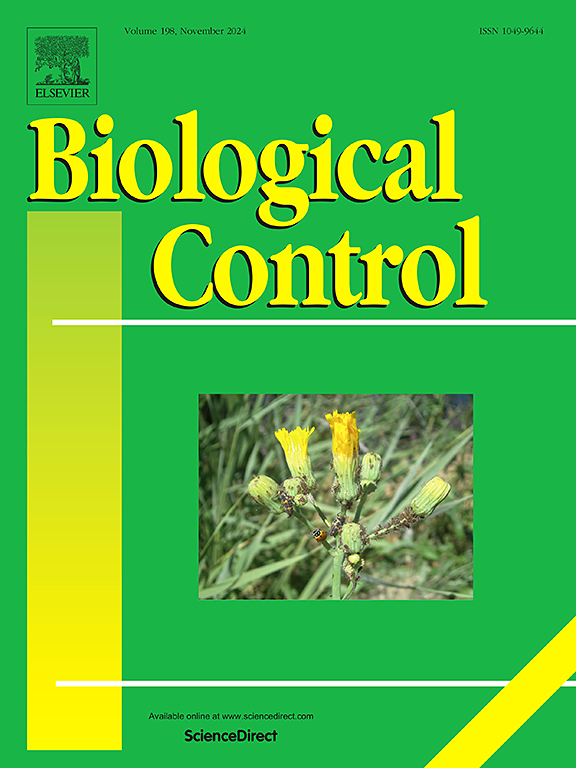Co-occurrence of entomopathogenic nematodes and earthworms enhances enduring biocontrol activity and microbial diversity in a naturalized plant-soil system
IF 3.7
2区 农林科学
Q2 BIOTECHNOLOGY & APPLIED MICROBIOLOGY
引用次数: 0
Abstract
Soil ecosystems host diverse microorganisms and fauna essential for terrestrial processes, with earthworms (EWs) and entomopathogenic nematodes (EPNs) playing crucial roles. EWs enhance soil health by improving aeration, porosity, and nutrient cycling, while EPNs, such as Steinernema and Heterorhabditis, manage pests by killing insects. This study aimed to assess the impact of EWs and their derivatives (cutaneous excreta, CEx), alone or combined with EPNs, on soil–plant dynamics, hypothesizing that their co-occurrence would alter soil properties, bacterial communities, EPN virulence, and plant performance. Using tomato plants and field soil, the study investigated different treatments: control, EW (Eisenia fetida), EPN (Steinernema feltiae), CEx, and combinations of EPN-EW and EPN-CEx, at two and four weeks post-application. Assessments included plant growth, EPN infectivity, soil properties, and bacterial profiling via 16S rRNA gene sequencing. Results showed no significant impact on plant growth. However, EPN virulence decreased after 30 days when applied alone but was maintained or enhanced when combined with EW or CEx. Combined applications of EPNs and CEx reduced Mg and Ca contents, while organic matter increased in the EPN-EW treatment. Bacterial community changes were observed 30 days post-inoculation, with increased alpha diversity in co-applications of EPNs and EWs. The co-application of EPNs and EWs resulted in beneficial impacts on soil properties, EPN virulence, and bacterial diversity. Timing post-inoculation was crucial in assessing these effects, only detecting those changes after 30 days, suggesting the need for further extended research to understand the duration of these changes. This study highlights the intricate interactions between EWs, EPNs, and plant-soil systems, emphasizing their potential impact on plant growth, soil nutrient dynamics, and soil organisms, highlighting the importance of timing in evaluating these interactions.

昆虫病原线虫和蚯蚓的共存增强了植物-土壤系统中持久的生物防治活性和微生物多样性
土壤生态系统拥有多种微生物和动物,对陆地过程至关重要,蚯蚓(EWs)和昆虫病原线虫(EPNs)起着至关重要的作用。EWs通过改善通气性、孔隙度和养分循环来改善土壤健康,而epn,如steinerma和Heterorhabditis,通过杀死昆虫来控制害虫。本研究旨在评估ewn及其衍生物(皮肤排泄物,CEx)单独或与EPN结合对土壤-植物动力学的影响,并假设它们的共同存在会改变土壤性质、细菌群落、EPN毒力和植物性能。利用番茄植株和田间土壤,在施用后2周和4周,研究了不同的处理:对照、EW (fetida Eisenia)、EPN (steinerema feltiae)、CEx以及EPN-EW和EPN-CEx的组合。评估包括植物生长、EPN传染性、土壤性质和通过16S rRNA基因测序的细菌谱。结果表明,对植物生长无显著影响。然而,单独应用EPN的毒力在30天后下降,但与EW或CEx联合使用时保持或增强。epn和CEx联合施用降低了土壤中Mg和Ca的含量,而EPN-EW处理增加了土壤中有机质的含量。接种后30 d观察到细菌群落的变化,epn和EWs共同施用增加了α多样性。EPN和EWs的共同施用对土壤性质、EPN毒力和细菌多样性产生了有益的影响。接种后的时间对评估这些影响至关重要,仅在30天后检测到这些变化,这表明需要进一步延长研究以了解这些变化的持续时间。本研究强调了EWs、epn和植物-土壤系统之间复杂的相互作用,强调了它们对植物生长、土壤养分动态和土壤生物的潜在影响,并强调了评估这些相互作用的时间的重要性。
本文章由计算机程序翻译,如有差异,请以英文原文为准。
求助全文
约1分钟内获得全文
求助全文
来源期刊

Biological Control
生物-昆虫学
CiteScore
7.40
自引率
7.10%
发文量
220
审稿时长
63 days
期刊介绍:
Biological control is an environmentally sound and effective means of reducing or mitigating pests and pest effects through the use of natural enemies. The aim of Biological Control is to promote this science and technology through publication of original research articles and reviews of research and theory. The journal devotes a section to reports on biotechnologies dealing with the elucidation and use of genes or gene products for the enhancement of biological control agents.
The journal encompasses biological control of viral, microbial, nematode, insect, mite, weed, and vertebrate pests in agriculture, aquatic, forest, natural resource, stored product, and urban environments. Biological control of arthropod pests of human and domestic animals is also included. Ecological, molecular, and biotechnological approaches to the understanding of biological control are welcome.
 求助内容:
求助内容: 应助结果提醒方式:
应助结果提醒方式:


